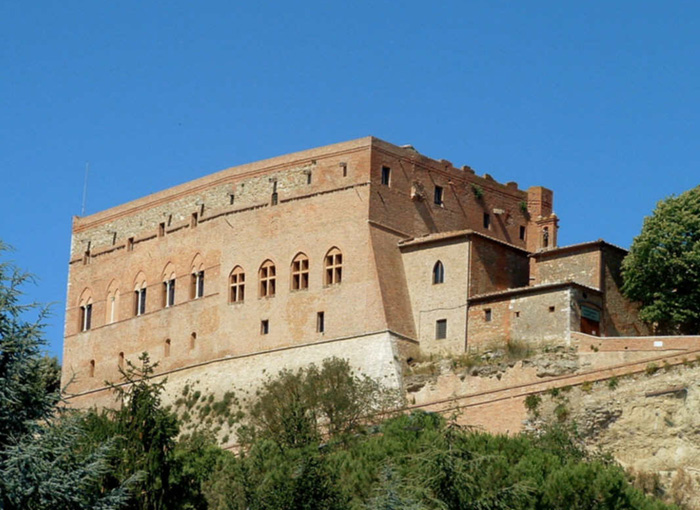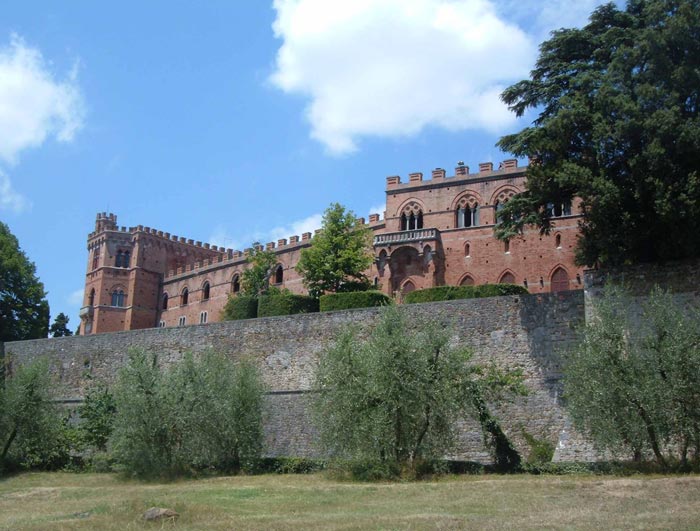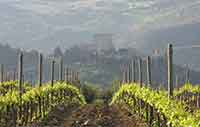Castello di Brolio |
| Majestic and huge, the Brolio Castle evolves over 1200 hectares of green vineyards, refreshing olive groves and dark woody forests of oak. Picturesque and perfect in its setting, the countryside unravels its beautiful farmhouses that punctuate the landscape with Siena seen in the hazy horizon. This beautiful scenery is reflected in a painting by Ambrogio Lorenzetti in the 1300s which is placed at the Town Hall of Siena. Walk into the interior of the castle and explore its interesting features. Come and stand in an atmosphere of solemnity at the small but appealing family chapel.
The castle of Brolio comprises of strong round towers and heavy fortifications to accommodate the new fire weapons of those days. The legend has it that the 'iron baron's' ghost in black still roams ceaselessly on a white horse at night. The name of the Brolio Castle is derived from the Longobardo term for an enclosed green space or orchard, 'Brolo'. With a watch tower, the fortress was transformed into a manor built in the romantic English style. Introduced by the Baron Bettino Ricasoli in 1835, the 'Gothic revival' was animated with brick that was so different from any other castle of that time. This ancient fortress was structured with Tudor windows and crenallated turrets built with a new type of stone called 'mattone' and pietra serena. Brolio Castle is a standing example of the various periods that evolved over the ages. The base of the castle reflects the early medieval structure and its walls are reminiscent of the Renaissance architecture and style. |
| The impressive Castello di Brolio dominates the southern Chianti Classico countryside and has done so for over ten centuries. Located on top of an isolated hill a few kilometers from Gaiole in Chianti, the castle has Lombardic origins and has been property of the Ricasoli family since 1141.
Even though it is closer to Siena, which can be seen in the distance and is just 20 km away, the castle has always been under the influence of Florence and used as one of its strategical outposts. Because of this, the castle was besieged and destroyed many times over the centuries. Every time it has been reconstructed following the style of the current age. It suffered its last attack during World War II, as can be noticed by the holes left by shrapnel all over facade. The castle we see today is partly the new-Gothic reconstruction ordered by Bettino Ricasoli in the 1800s. The Renaissance gardens with typical geometric shaped bushes and the English woods are stunning and from here you can admire a breathtaking view over the Chianti region. On the horizon, during clear, sunny days, you can clearly see Siena. Inside the castle you can visit the Chapel of San Jacopo and the crypt with the family tombs and a small museum housing the Ricasoli collection. The collection displays several valuable family weapons, as well as documents and personal belongings of Bettino Ricasoli, together with part of his personal fossil and mineral collection. You can visit the garden and the small museum in Castello di Brolio, the rest of the castle is still home to the current Ricasoli baron and his family. The "classic" tour is a free visit to the gardens around the castle. The "historical" tour includes the gardens and a guided tour to the museum, while the "research and experimentation" tour is upon reservation and includes the guided tour to the wine cellars and experimental vineyards of the estate. |
Bettino Ricasoli, nicknamed the Iron Baron for his strong resolve and conviction of his ideals, was one of the most important politicians in the 19th century and promoter of Italian union, as well as major of Florence. His name is strongly related to Brolio and Chianti wine. He was the first to create the recipe for what became the wine for the region, the great red Chianti wine. He determined the mix of three different grape varietals in different quantities; his recipe was used up until 1967 to produce Chianti Classico DOC. Bettino Ricasoli was an essential player and pioneer in developing the Italian wine making sector. |
|
Spectacular panoramic scenery in Podere Santa Pia, with views that stretch all the way to the Mediterranean sea and the islands of Montecristo and Corsica
|
|
||||
| Wine regions | Podere Santa Pia |
Podere Santa Pia, view from the garden on the valley below |
||
|
||||
The castle of Brolio is situated in the center of the area of Chianti that belongs to the province of Siena. It can be reached easily from Siena following the indications for Castelnuovo Berardenga or from the exit 'A1 Valdarno' following the statal road (SS) 408. |
||||
 |
||||
| The castle of San Giovanni d'Asso |
||||





